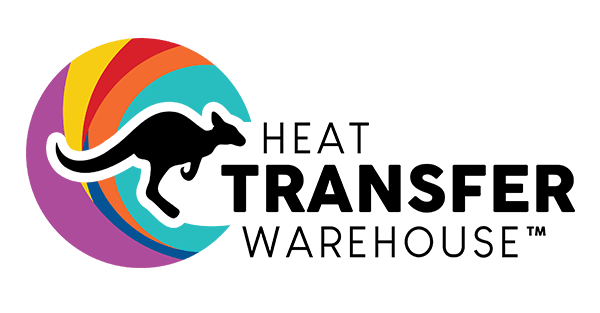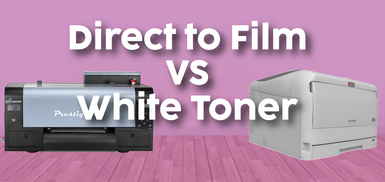Posted by Heat Transfer Warehouse on Nov 8th 2024
Comparing DTF and White Toner: Which is Right for You?
Direct-to-Film (DTF) and White Toner printing are two popular methods for creating custom designs on various substrates, each with unique capabilities, strengths, and applications. Here, we’ll break down the main differences between DTF and White Toner printing to help you decide which is best for your project.
What is DTF Printing?
DTF printing is a process where designs are printed directly onto a specialized PET film using a DTF printer and inks. The print is then coated with a layer of adhesive powder, which bonds the ink to the substrate when heat pressed. This method allows for high-quality, full-color prints that can be transferred onto various materials, primarily textiles like cotton, polyester, and blends. It’s a go-to choice for apparel, thanks to its durability and vivid colors.
Advantages of DTF Printing
- Roll Printing Capability: DTF printers can handle rolls up to 24" wide, making them suitable for larger designs and projects.
- Higher Resolution and Color Vibrance: DTF printing offers superior resolution and vibrancy, resulting in stunning visuals that stand out.
- Basic Heat Press Requirement: You can use a standard heat press for DTF transfers, simplifying the setup and reducing equipment costs.
- Soft Hand Feel: DTF transfers have a soft feel even without rasterization, providing a comfortable finish on garments, whereas White Toner can sometimes feel papery, especially with thicker graphics.
- Excellent Durability: DTF prints can last for 50+ washes, maintaining their quality and color integrity over time.
- Superior Stretch: DTF transfers provide excellent stretch, making them ideal for elastic and fitted garments.
- Better for Medium to Large Runs: DTF printing is efficient for larger production runs, allowing for quick and consistent output.
Disadvantages of DTF Printing
- Equipment and Material Costs: Manual DTF printers and inks can range from $3,000 to $5,000, while automated setups range from $10,000 to $50,000, making it a considerable investment.
- Maintenance and Processing Needs: As an ink-based system, DTF requires continuous operation to prevent clogging or streaking. The adhesive powder used in the process requires proper ventilation and PPE (such as a respirator) due to fumes.
- Slower Print Speed: Compared to White Toner, DTF printing generally has a slower processing time and requires additional steps, like curing the adhesive powder.
Custom DTF Transfers
If you want to enjoy the benefits of DTF (Direct-to-Film) prints—like their durability, flexibility, and vibrant colors—without the expense or upkeep of owning DTF equipment, starting with our Custom DTF Transfers is a fantastic option! Purchasing ready-made DTF transfers gives you access to all the qualities that make DTF so popular, without the upfront investment or maintenance worries. Whether you're not ready to buy your own equipment or simply prefer convenience, Custom DTF Transfers offer a cost-effective way to bring your designs to life with ease. Check out our Custom DTF Transfers here and enjoy professional, high-quality prints that are ready to press!
What is White Toner Printing?
White Toner printing uses a specialized printer that includes white toner, which traditional color printers lack. This method is ideal for designs on dark or colored substrates, as the white toner provides a solid background layer to make colors stand out. White Toner printing is commonly used for garment decoration, promotional items, and hard-surface applications.
Advantages of White Toner Printing
- Minimal Maintenance: Toner-based printing systems require little to no maintenance, even after idle periods. This flexibility is ideal for businesses with variable production needs. It requires less maintenance than a DTF printer does.
- Extended Idle Time: White Toner printers can sit idle for long periods without issue, which is advantageous over ink-based systems like a DTF printer that need constant operation.
- Fast Print Speed: White Toner has a quick processing time of around 3 minutes, making it efficient for short-run jobs.
- Low Environmental Impact: White Toner printing requires no special ventilation, extraction, or extra safety gear, as it produces no harsh fumes unlike a DTF printer.
- Broad Substrate Compatibility: White Toner transfers work on a variety of surfaces, including magnets, banners, window clings, labels, wood, metal, ceramics, glass, and fabrics which makes it more versatile than DTF printing.
- Equipment Cost: With equipment costs ranging from $3,000 to $10,000, White Toner systems are typically a more moderate investment than investing in a DTF printer, which can be anywhere from $3,000-$5,000 for a manual or $10,000 to $50,000 for an automatic.
Disadvantages of White Toner Printing
- Moderate Durability on Fabrics: White Toner prints, especially on garments, may experience cracking or peeling after several washes, making it less durable than DTF on wearable items.
- Limited Flexibility on Fabric: White Toner prints are less flexible on stretchy fabrics than DTF and may have a “papery” feel.
Key Comparisons
| Feature | DTF Printing | White Toner Printing |
| Substrate Options | Primarily fabrics (cotton, polyester, blends) | Fabrics, wood, metal, ceramics, glass, magnets, banners, clings, labels |
| Durability | Excellent (50+ washes) | 15-50 washes depending on the paper used |
| Color Vibrancy | Very vibrant | Excellent on dark colors |
| Flexibility | Excellent stretch | Limited stretch, “papery” and thicker feel |
| Initial Investment | $3,000-$5,000 for manual, $10,000-$50,000 for automated | $3,000-$10,000 |
| Maintenance Needs | Requires continuous operation to prevent clogging; PPE needed for powder | Minimal maintenance; no ventilation or PPE needed |
| Print Speed | Slower | Faster |
| Ideal for | Textile production, large production volume | Broad range of applications, smaller production volume |
Which Should You Choose?
Choose DTF Printing If:
- Your focus is on creating prints primarily for fabrics made of cotton, polyester, and blends.
- You need vibrant, long-lasting, stretchy prints with a soft hand that can withstand 50+ washes.
- You require a method that allows for wider roll printing, ideal for medium to large production runs.
Choose White Toner Printing If:
- You want to print on hard surfaces or a wide variety of substrates like wood, glass, magnets, and banners but also fabrics as well.
- You prefer a process with little maintenance that doesn’t require continuous operation.
- You value a quick setup with minimal environmental impact, no fumes, and no ventilation needs.
Conclusion
Both DTF and White Toner printing offer unique advantages depending on your project’s requirements. DTF printing is ideal for high-quality, durable apparel prints, while White Toner printing shines for hard surfaces, versatile applications, and ease of maintenance. Understanding the strengths of each method will help you select the printing technology that best meets your design needs and budget.

